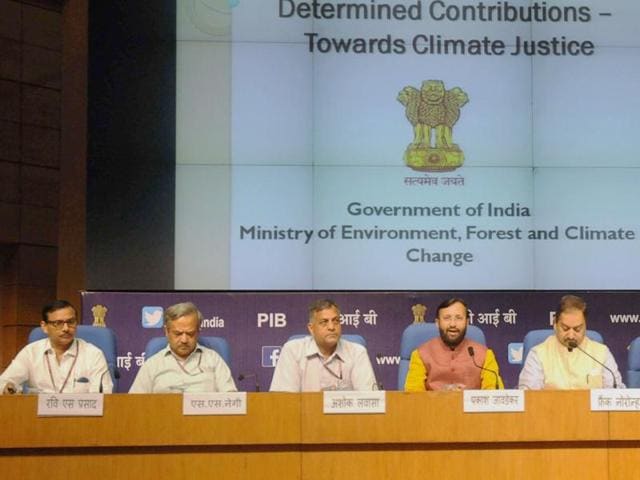India’s commitment to carbon cuts needs to be more detailed
What India, China, the US and some others have promised on carbon emission cut needs to have more depth.
On October 2, the government submitted India’s Intended Nationally Determined Contribution (INDC) to the United Nations Framework Convention on Climate Change (UNFCCC). The INDC is seemingly ambitious, aiming to achieve “about 40% cumulative electric power installed capacity from non-fossil fuel based energy resources by 2030”, and reducing “the emissions intensity of its GDP by 33 to 35 per cent from 2005 levels”. This sounds like a major shift towards cleaner sources of energy, and less polluting ways of achieving economic growth.

Undoubtedly, several actions listed in the INDC are commendable, including energy efficiency in industry, expanding mass public transport systems, and rooftop solar power. However, at its core, the INDC is disappointing.
First, the INDC uses the term ‘non-fossil fuels’ rather than ‘renewables’. This makes it possible to include a huge expansion of nuclear power from the current 10 gigawatts to 63 gigawatts (GW) of installed capacity by 2032. It calls this power ‘safe’ and ‘environmentally benign’, which, after Chernobyl and Fukushima, and considering the impacts of nuclear fuel mining and unsafe nuclear waste, is plain delusional or dishonesty.
Second, within ‘renewables’, the INDC includes ‘a vast potential of more than 100 GW’ of hydropower. Of India’s 46 gigawatts of currently installed hydro capacity, an overwhelming 42 GW comprises large hydro. Since there is no prioritisation for micro-hydel, the INDC implies a further expansion of large hydro projects. There are already dozens of such projects under construction or being planned across the fragile Himalayan ecosystem. Social displacement, ecological damage to rivers and forests, impacts on agriculture and people downstream, and methane emissions from reservoirs, will intensify. Large hydro is simply not ‘clean energy’.
Third, large-scale solar and wind have environmental and social problems, e.g. grabbing community lands. The INDC could have focused a greater part of the 40% target on decentralised renewable energy (DRE), which is ecologically less damaging, and faster in providing energy access to the poor. Large-scale energy production goes into centralised grids, from where access to the poor has been a massive problem in India. This issue of energy justice is mirrored by the issue of energy democracy: Who decides about energy source, distribution and price? With DRE, decision-making can be with communities who need the energy.
Fourth, the target for reducing the emissions intensity allows for a massive rise in carbon emission. Assuming average GDP growth of 5-6% over 2005-30, India’s emission in 2030 would be 2.5-2.8 times what it was in 2005; given current figures (about 1,904 million tonnes of carbon dioxide equivalent in 2007), this will mean about five billion tonnes by 2030. This huge rise in future emissions is often justified, by talking of a ‘development deficit’. But social indicators - electricity access (the INDC itself says 304 million people are still without electricity), real wages, poverty levels and insecure employment - seriously question the assumption that the poor will benefit substantially from the economic growth behind this rise.
In the INDC, ‘clean coal’ has been slipped in as ‘clean energy’, which is highly misleading. ‘Dirty’ or ‘clean’, coal has to be mined from mostly forested and inhabited areas, so its expansion will mean massive new deforestation, displacement, and poisoning.
The INDC also aims to enhance carbon sequestration (trapping) by 100 million tonnes of CO2-equivalent per year, by afforesting and improving forest cover over 10 million hectares. The tendency so far has been to create plantations of few species, taking lands from communities dependent on them (often in violation of their rights), and planting over non-forest ecosystems like grasslands. A commitment towards more community-based, biologically diverse, and rights-based strategies of enhancing ecosystems would have broken new ground, but is missing.
Two final points. The government is yet again hiding behind the poor. India’s annual per capita emission, 1.56 million tonnes, it says, is low “because Indians believe in nature friendly lifestyle and practices”! This ignores the fact that 175,000 households in India with assets of over a million dollars have per capita carbon emissions higher than the average American or European. India’s per capita emission is low because of the extreme (and growing) inequalities in income, consumption and accumulated wealth, partly resulting from current forms of economic growth.
Further, reducing risk and improving the capacity of people to adapt to climate change is linked to effective poverty eradication, improving food security through sustainable farming or other livelihoods, biodiversity maintenance, public health measures, and community resilience. These linkages have not been made explicit, nor is there a commitment to contain the rampant consumerism of India’s rich. This also relates to seriously reorienting today’s energy and material-heavy pattern of development, but the INDC sidesteps this.
Also missing is a sense of urgency. Globally, various climate feedback processes are taking the planet beyond a tipping point, after which it will be impossible for us to intervene. The INDCs that India, China, the US and other major emitters bring to the summit in Paris need to be far more ambitious and qualitatively different if the planet is to have a reasonable chance of avoiding dangerous levels of global warming.
(Ashish Kothari is with Kalpavriksh, Pune; Nagraj Adve is a member of India Climate Justice. The views expressed are personal)





